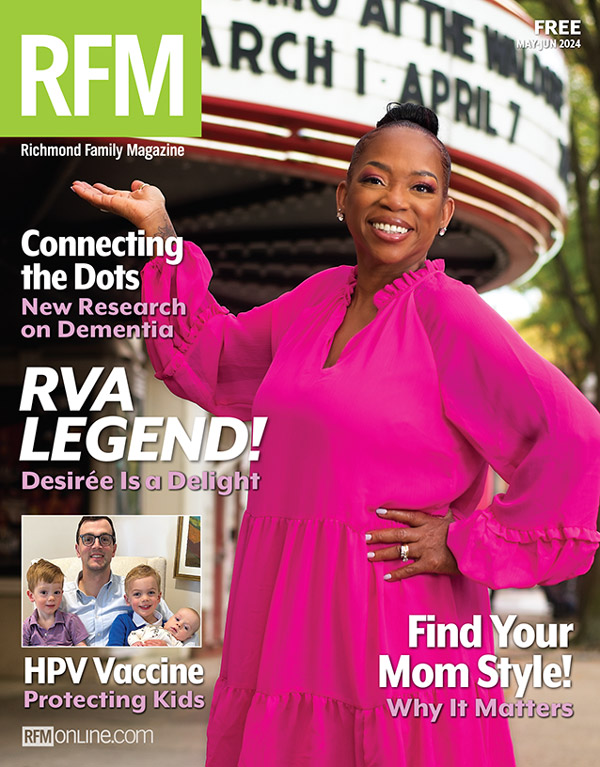When Kim Moncrief, Henrico wife, mother, and entrepreneur, recalls an annual exam with her gynecologist, she remembers an eerie conversation between physician and patient, and a recommendation that she now realizes probably saved her life.
Even though, Kim, who was thirty-eight at the time, hadn’t yet reached the age that doctors usually suggest having a mammogram, a few signs indicated that the time was right for the x-ray that screens for breast abnormalities.
“My doctor said she wouldn’t normally recommend having a mammogram until age 40. I had a little family history, but not a lot. I remember her saying, ‘Something just keeps telling me to just go ahead and send you now. Do you want to do that or wait?’”
Kim didn’t wait. She trusted her OB/GYN, her instincts, and that eerie feeling she had experienced during her check-up, and she scheduled her first mammogram. “And thank goodness I did, because I never would have known,” says Kim. “There was no lump that I could feel. There wasn’t anything detectable. I never would have known at all.” Kim was diagnosed with early stage cancer in one of her breasts. Her doctors recommended a lumpectomy and radiation.
For Kim, this was an unsettling diagnosis, but not as devastating as it might have been for some women. By this point, she was used to scary news. In a way, she was used to fighting for her family’s life. Kim and her husband, Johnny, had faced the unknown together before, advocating within the healthcare system for their son, Logan, from the day of his birth just two years before her breast cancer diagnosis.
Breast Cancer and Fertility
Born with Down syndrome in 2006, Logan came into the world with a hole in his heart. At three days old, and weighing a touch over four pounds, Logan was transported to Charlottesville with his parents, where he underwent his first heart surgery. At three months, Logan returned to UVA Medical Center in Charlottesville for more extensive heart surgery. “We basically spent the entire first year of his life in the hospital,” Kim remembers.
After Logan’s heart surgeries, Kim and Johnny welcomed the opportunity to spend more time at home without having to constantly worry about their son’s heart. “We were finally past that and able to enjoy him without being in the hospital all the time.”
The hole in his little heart was large enough that it couldn’t be fixed completely, but looking at him, you would never know it. The doctors and the Moncriefs were confident of Logan’s prognosis.
Even though Kim and Johnny were used to hospitals, healthcare issues, and medical specialists because of Logan’s challenges, Kim admits that dealing with her own diagnosis and subsequent surgery was a little more complicated.
“It was really scary. I had never had surgery on my body at all, so I was terrified,” says Kim. “And, this all happened, while I had a 2-year-old with special needs and my beloved aunt was dying of ovarian cancer.”
Kim did feel fortunate that her breast cancer treatment did not impact her fertility, as it does for many women. Consequently, with Kim closing in on 40, as soon as she was given the medical green light to attempt another pregnancy, the couple got serious about family expansion. According to Kim, they got lucky—and fast. In fact, according to Kim, they were “absolutely shocked!” and doubly blessed when the couple found out they had conceived twins. Logan would soon be a big brother to a pair of siblings.
Family Life and a Breast Cancer Diagnosis
Isabella and Gibson were born in November 2009. But Kim and Johnny didn’t have long to bask in the joy of bringing healthy twins into the world. When the babies were just four months old, Kim’s mammogram revealed that the cancer had returned to the same breast.
She was devastated. “The second time I thought, This is not happening! It was like a nightmare. It was much more traumatic the second time. I don’t know why,” Kim says.
This time, doctors recommended a mastectomy. Many women these days are opting for a total mastectomy, also known as a bilateral or double mastectomy, to eliminate the chance for recurrence. Kim chose to have a single mastectomy. “I talked with the doctors, and everybody was pretty confident that a lot of times it can happen in one side and not the other—ever.”
Clifford L. Deal III, MD, is a partner with Richmond Surgical who specializes in breast and general surgery and treats patients like Kim. He says that double mastectomy rates have doubled in The United States over the decade. “It’s a very personal conversation with the patient to consider all options. Emotional considerations about breast surgery play an important role. Surgical decisionmaking is highly personalized, which is why a close relationship with your surgeon is critical,” says Dr. Deal.
Kim didn’t want to have both breasts removed. “I was always confident with my body and my breasts. The doctors felt like they could work with me and through plastic surgery make me look really balanced and look great again,” the mother of three says. “It would never be the same, but they would work really hard to do the very best. And, they did.”
Dr. Deal, who has specialty training in oncoplastic surgical techniques – an approach to surgery where the goal is to remove the the tumor and begin the breast reconstruction process at the same time – says advances in medicine give women more options today and offer more hope. “Over the last 50 years, surgery has evolved from very large operations that removed the muscle, all of the breast tissue, and all of the lymph nodes, to generally much smaller operations,” Dr. Deal says. “Today, it’s completely reasonable to get a lumpectomy and radiation or a total mastectomy. The reconstructive options are much better, and in general, recovery is much faster.”
Dr. Deal continues, “The important thing is to have an in-depth, comprehensive discussion with your surgeon. Explore and understand all of the options, the risks, the benefits, and the alternatives. You should see your surgeon as your partner and advocate as you make these decisions.
Throughout Kim’s ordeal, which was not without its hurdles, she sought to stay upbeat and true to her own emotions while attempting to meet the needs of her family.
“Of course I think she’s amazing,” Kim’s husband Johnny says. “She was really strong to come through everything with a never-give-up attitude.” And, the challenges were more than just physical for the Moncrief family. Around the time of Kim’s second breast cancer diagnosis, Johnny lost his job. Since Kim couldn’t work, the two of them teamed up and got creative, inspired by their commitment to families with children who had Down syndrome.
In all, the couple started five different businesses to make ends meet and support local Down syndrome organizations at the same time. One of those businesses, Miracles in Motion, helps kids with conditions like Down syndrome and autism express themselves through dance. A dancer all of her life, Kim began offering classes to children with special needs. It has grown from a class of five children several years ago to twenty-nine students, dancing in three locations around Richmond at Ann Catherine Cross School of Dance.
“I wanted to show the community that these kids can do everything that other kids can do. They can get on stage and bring the house down,” Kim exclaims. “And they do!” Kim says the classes are working wonders for the children and their confidence, her son Logan included, who at five, is full of life and has lots of energy. She also believes the performances raise awareness and acceptance of children with special needs.
With a clean bill of health, Kim says this year is about catching up. She adds with a huge smile, “I’m just really determined, and I really love life. So, I don’t let things stop me.”
Kim continues to inspire her family and her friends, not to mention her students and their parents. The mothers all made appointments to get mammograms. And if one of those women needs support, Kim will be there. “I always say, it’s not an easy road at all, but it saves your life – and so that makes it easy.”







